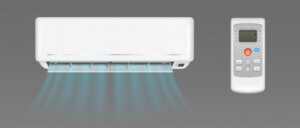
Change Your HVAC System Filters
Changing filters is one of the most important things you can do to keep your HVAC system in good working order as fluctuating humidity levels can affect the functioning of your unit. Depending on your home’s HVAC usage, the air filters should be changed monthly and/or as per manufacturer instructions. Changing system filters regularly will help reduce your home’s energy consumption anywhere from 5 to 15% according to the Department of Energy.
Clear the Condensate Line
Every air conditioner has a condensate line that removes water created when the evaporator exchanges the refrigerant from liquid to gas. Your condensate line will be situated on the exterior of your house, either beside your HVAC unit or sometimes on the opposite side of your house. Ensure the exterior condensate line isn’t clogged and is exhibiting proper drainage; remove any debris from on or around your condenser unit. Do regular maintenance on the condensate line by adding 1 cup of vinegar into the line each month to keep it clean and mildew-free.
Clean the Evaporator Coil
After you’ve turned off the HVAC unit, removing dust from your air conditioner’s evaporator coil can easily be done by using a vacuum cleaner. If there’s stuck-on debris, you can use a soft bristle brush to break away any dirt but bear in mind the coils are delicate so don’t use too much force. While there are commercial and DIY solutions available for cleaning evaporator coils, experts don’t recommend doing so on your own as the solution runoff, if not properly caught in the drain pan, could easily damage the electronic controls or the blower motor which could result in preventable expensive repairs.
Clean the Drain Pan
Situated underneath the evaporator coils is a drain pan that catches any forming moisture which then runs out through the condensate line. Sometimes a drain pan can become clogged causing leaks and/or an HVAC system that just won’t start. Use a shop vacuum to remove any accumulated water and scrape out any sludge that may have accumulated. Clean the drain hole with a small wire brush and then sanitize the drain pan by using 2 cups of vinegar. There are also commercially available condensate pan treatment tablets to help keep things in working order.
Change Your Thermostat Batteries
Most programmable thermostats come with a low battery warning but it never hurts to routinely change your thermostat batteries annually in the spring or fall. Don’t think you’ll remember? The home maintenance scheduling feature of DomiDocs comes with a list of suggested scheduled home maintenance tasks along with handy alerts to keep you on track as a homeowner, while DomiDocs HomeLock® provides proactive protection to keep your home safe from fraudulent activity.
Set Your Thermostat Temperature
To maintain an optimum year-round temperature in your home, the American Society of Heating, Refrigerating, and Air-Conditioning Engineers recommends setting your thermostat to 70 degrees Fahrenheit for heating and 78 degrees Fahrenheit for cooling. It’s a good idea to periodically check the thermostat settings as other household members could be making their own adjustments, which may need to be brought back to the recommended baseline.
Professionally Service Your HVAC System Annually
While you could replace your HVAC compressor belt and/or pulleys yourself, this and other HVAC maintenance tasks are probably best left to the professionals. The Department of Energy recommends having your HVAC system inspected and serviced by an HVAC contractor once a year. Not sure who to call? Consult the DomiDocs list of trusted nationwide contractors near you. HVAC experts will conduct a thorough inspection examining:
- bearings/moving parts and will lubricate as necessary
- ductwork/vents
- electrical system/connections
- fan motor, blowers, and blades to ensure proper airflow
- flue attachment to the furnace
- furnace for possible gas leaks
- gas pressure
- heat exchanger/heating elements
- ignition burner
- looking for refrigerant leaks
- the refrigerant charge
Did You Build a New Home?
If you build a new home, make sure your HVAC system has been registered with the manufacturer within 90 days of closing as some companies provide additional warranty years on parts coverage once registered. This also means you’ll be updated if any manufacturing issues occur with your specific unit.
Now that you’ve got tips to get your HVAC system in tip-top shape, take a look at the bigger picture in regards to homeownership as the FBI reports home title and mortgage fraud crimes are on the rise in America. You can proactively protect your home from fraud with DomiDocs HomeLock®, the most advanced home title tracking and digital property monitoring available. Don’t become the next victim! Watch the HomeLock® video and sign up today to protect your home and family.
Author – Connie Motz
